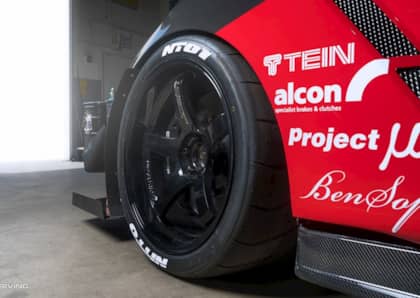Drag Radials On The Street: What Are The Pros and Cons?
Drag radials are an appealing choice for drivers who own street cars that every so often hit up the local strip. They're also attractive for anyone running high horsepower in a cruiser seeking a straight line traction advantage that's often hard to find with a traditional radial performance tire. Street-legal, DOT-compliant drag radials walk the line between a tire you can drive every day and one that will provide top tier performance in the quarter mile on a prepared surface. As with any specialized tire, however, there are limits to what they can accomplish when taken outside the setting in which they were designed to excel.

Should you run drag radials on a daily basis, or should you save them for the strip and swap on a second set for regular driving?
What Drag Radials Do Well
Traditional bias-ply drag slicks simply can't handle the stress of regular driving. With their ultra-flexible sidewalls, they aren't suited for cornering, nor do they manage heat build-up well at sustained highway speeds. That ability to wrinkle the sidewall is a massive boon that adds traction and protects the drivetrain when launching, but it also leads to less-than-confident handling due to flex, not to mention dangerous wet weather performance thanks to their slick, tread-free surface.

Drag radials were created to address each and every one of these issues. Their steel-belted construction is considerably stronger than the crisscrossed nylon cords of a bias-ply, features a sidewall that doesn't deform nearly as much under load, and resists high speed heat. In order to be DOT-compliant, drag radial tires like the Nitto NT555RII are also grooved to channel water away and most designs provide at least a reasonable level of handling and safety in the rain.

Although drag radials don't wrinkle as much as a traditional bias-ply tire, they do offer a softer 'wrinkle wall' sidewall that works together with a much stickier rubber compound to significantly improve traction off the line. That same compound doesn't need as much heat as a bias-ply to grab the ground, either, which means there's less of a burnout needed to get them up to proper temperature.
Understanding The Compromises
All of the above might make drag radials sound like a good fit for both daily driving and drag strip fun, but there are some compromises inherent in their design that need to be taken into consideration.

Tread depth on a drag radial typically hovers in the 1/32nd to 5/32nds of an inch range, which is significantly more shallow than a street performance tire (which starts at 10/32nds of an inch). Combined with the fact that there are far fewer channels to begin with, this makes drag radials less resistant to hydroplaning, especially if you encounter standing water on the road.

The soft wrinkle wall of a drag radial is also not the best option for carving corners. Although much stronger than a bias-ply, it's not intended to provide crisp handling or deliver strong feedback to the driver, and twisty roads can be a challenge for a drag radial to deal with at higher speeds.

Then there's the compound itself. A drag radial's rubber is often listed at '00' in terms of wear resistance, which means you won't get nearly as many miles out of a set in regular driving as you would a standard performance tire. You may be looking at a 3,000 mile to 5,000 mile window before replacement, which can increase your yearly costs depending on how much you drive your vehicle during the season.

Finally, temperature is a key consideration for drag radial use. Like any ultra high performance tire, drag racing rubber offers optimal stickiness in warm conditions, which means when the mercury drops to between 40 degrees and 60 degrees F you won't be able to tap into the extra traction that they have to offer. Cold, wet roads can be a risky proposition in a high horsepower car riding on drag radials (click here for the proper handling of Nitto R compound tires in colder weather climates).
Making The Right Choice
Where does this leave you when it comes to making your decision about running drag radials on the street? In simple terms, if you plan on driving your car only occasionally (to the track and back, or on short trips), during the warmest months of the year, and don't have to drive in the rain, then a drag radial is a good choice as a 'do-everything' tire.

If you're using your vehicle as a commuter, however, and only occasionally hitting the track on weekends, it makes more sense to throw on a set of drag radials on an 'as needed' basis. For daily driving, a dedicated performance tire (such as the Nitto 05 or Nitto NT555 G2) is a not only a safer bet for handling the occasional rain storm or cold snap, but one that will improve your driving enjoyment when not at the strip.

Of course, these aren't your only two choices. Some companies offer a pairing of performance tires for the front and drag radials for the rear that are designed to be used together. The NT555 G2 and the NT555RII, for example, provide a strong combination of wrinkle wall contact patch for the rear and a stiffer, better-handling sidewall for the front, which mitigates some handling and wear concerns.

Some drag radial tire designs are intended to be more street-friendly, such as the Nitto NT555 RII. With a higher treadwear rating than the NT05R, the NT555RII lasts longer in standard driving, potentially as long as 10,000 miles. It also provides more tread depth and additional grooving to fight against hydroplaning, improving its performance and safety in the wet.

Ultimately, your drag radial choices come down to how you drive your car, the climate you live in, and how much of a budget you're willing to dedicate to replacing worn out rubber over the course of a season. With so many options available, there's no doubt you'll be able to find a tire combination that provides you with the traction, durability, and safety you require.











